Cornell’s Contributions to Viticulture
– E. B. White ’21
Cornell University has a long history of ties to the wine and grape industry. Cornell’s New York State Agricultural Experiment Station has been at the forefront of grape variety and cultivation development for over 100 years. By working to combat grape diseases and by developing techniques to increase efficiencies in grape growing and harvesting, the Station has been instrumental in the success of the United States wine and grape industry.
Cornell’s modern Enology and Viticulture Program in the College of Agriculture and Life Sciences provides an unparalleled setting for professional research and student learning. In 2008, Cornell announced the expansion of its Enology program with plans for a new teaching winery on the Ithaca campus.
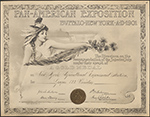 |
Pan-American Exposition. Award Certificate, 1901. [zoom] Buffalo, New York hosted the 1901 Pan-American Exposition, a World’s Fair with over 8 million visitors. The horticulture building displayed produce from around the country, with a viticulture display featuring more than 2000 plates of grapes. During judging of the fruits and vegetables, Cornell’s New York State Agricultural Experiment Station took home several awards, including the one seen here. The Station was also recognized for producing the finest new hybrid grape variety. New York’s grapes earned more awards at the exposition than those of all other states combined. |
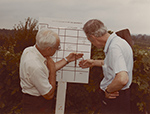 |
Nelson Shaulis and Cornell President Frank H. T. Rhodes at the New York State Agricultural Experiment Station vineyards. Photograph. Geneva, N.Y., August 17, 1977. [zoom] Nelson J. Shaulis is one of many notable Cornell professors to have dedicated his life to the study of viticulture. Shaulis’s research resulted in the widely used Geneva Double Curtain system of training grapes, which increased vineyard production around the world. He was also instrumental in developing mechanical grape harvesters. |
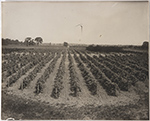 |
New York State Agricultural Experiment Station vineyards. Photograph, ca. 1930. [zoom] In addition to its vineyards in Geneva, N.Y., the New York State Agricultural Experiment Station also owns a vineyard laboratory in Fredonia, N.Y. This photograph of the Fredonia location shows what a well-kept vineyard should look like. Image courtesy of Lee Library, New York State Agricultural Experiment Station. |
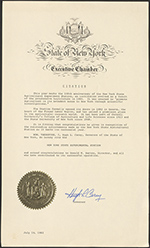 |
State of New York. Executive Citation Signed by Governor Hugh Carey, July 12, 1982. [zoom] The New York State Agricultural Experiment Station celebrated its 100th anniversary in 1982. As part of the celebrations, the Station received official citation from New York State Governor Hugh L. Carey. The Legislature in Albany also proclaimed the week of July 11-17, 1982 “New York State Agricultural Experiment Station Week.” |
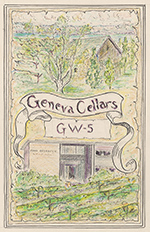 |
Geneva Cellars. Wine Labels, 1969. [zoom] | Additional images:  
When staff conduct wine research at the New York State Agricultural Experiment Station, they often require wine labels to identify the wine they produce. This label design, seen here along with two drafts, was drawn by noted Station viticulturist George W. Remaily. Because this wine had been produced in small quantities and was not for sale, the labels are marked “Experimental Material” or “Experimental Use” for regulatory purposes. |
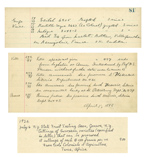 |
New York State Agricultural Experiment Station. Excerpts from Specimen Ledger Books, 1898, 1926, 1927. [zoom] These ledger entries show that grape vines were brought to the Station from many far off places. Importing varieties from around the globe to Geneva provided researchers with more options for grape breeding and development. The top entry, from 1927, shows vines being purchased from the Beaujolais area of France. The middle entry, from 1898, shows grapes being checked in from Siberia, likely for the study of their cold hardiness. The bottom entry, from 1926, shows the price paid for cuttings sent from Tunisia. Images courtesy of Lee Library, New York State Agricultural Experiment Station. |
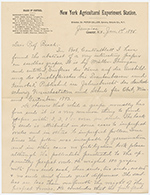 |
F. C. Stewart. Letter to Professor Spencer A. Beach. January 1, 1895. [zoom] | Additional images:  
Spencer A. Beach worked as a horticulturist at the New York State Agricultural Experiment Station for over a decade. While his major contributions involved apples, he also devoted time to grapes. Together with Cornell’s Liberty Hyde Bailey, Professor Beach helped set up the horticulture display at the 1901 Pan-American Exposition, which won the award certificate shown in this case. In this letter, Station plant pathologist F. C. Stewart discusses seedless grapes, almost 90 years before the development of the Remaily seedless grape seen below. |
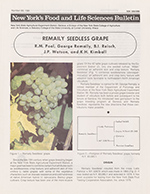 |
Food and Life Sciences Bulletin. New York, 1981. [zoom] The Remaily seedless grape was named for viticulturist George Remaily, who was involved with Cornell and the New York State Agricultural Experiment Station for many years. His studies of grape breeding led to the development of several new grape varieties, including the first cold hardy seedless table grapes. This particular variety combines all the traits that make an ideal table grape: seedlessness, cold hardiness, phylloxera resistance, a good texture, and an adherent skin. |
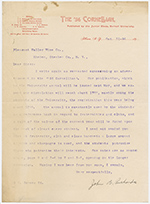 |
The 1896 Cornellian. Letter to Pleasant Valley Wine Company, October 31, 1894. [zoom] Pleasant Valley Wine Company advertised within the pages of the Cornell University yearbook. Charles Davenport Champlin II, the grandson of Pleasant Valley’s founder, attended graduate courses in chemistry at Cornell to help with winemaking, he later assumed management of the company. |
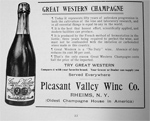 |
The 1910 Cornellian. Pleasant Valley Wine Company advertisement, 1910. [zoom] |